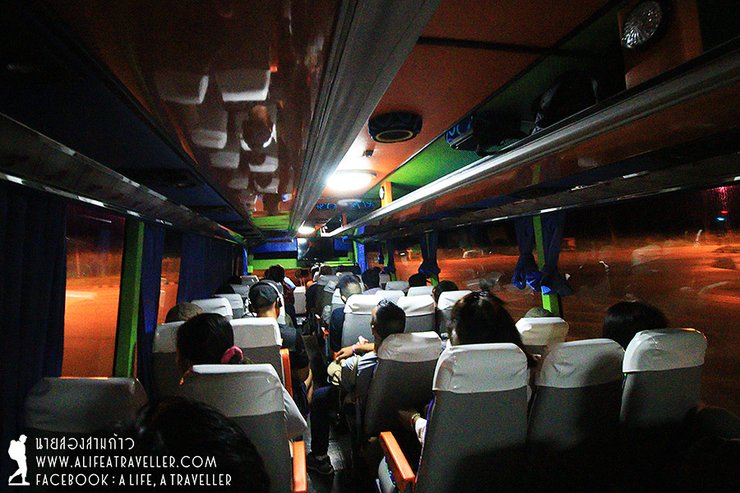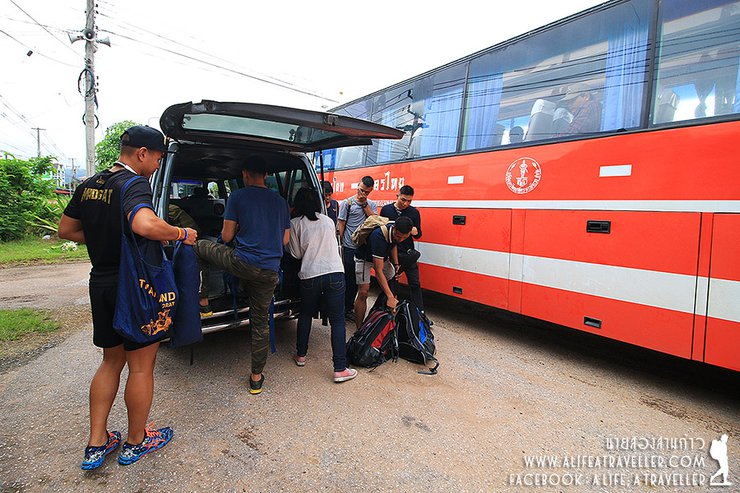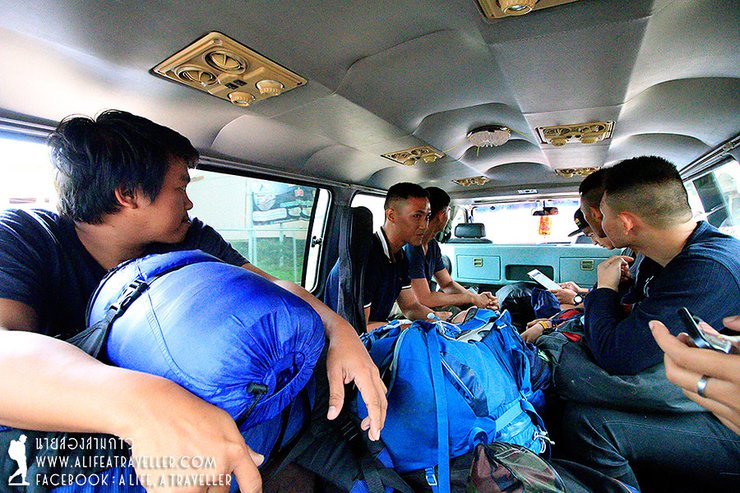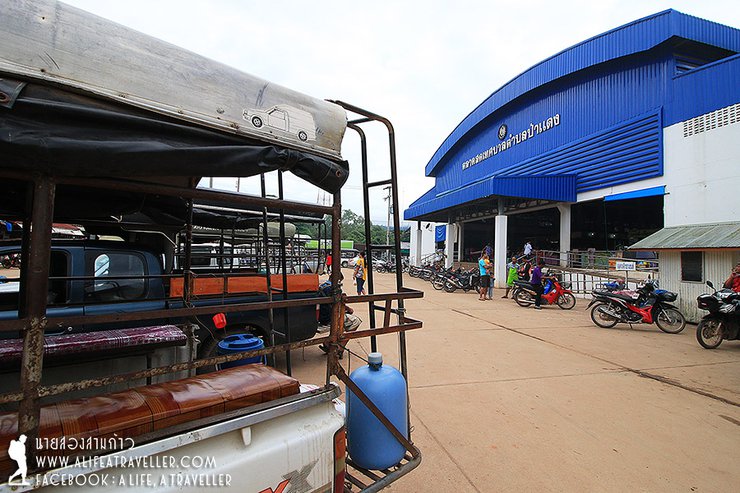Rain, mist, wild ginger flowers, Phu Soi Dao... Just thinking about it is exciting. I've been watching reviews for years but haven't had the chance to visit until the end of August. When a friend who had just hiked with me at Doi Luang-Doi Nok, Phayao (read the review of that trip >>> http://bit.ly/2bZx47z) messaged me that he was eager to plan another challenging trip, I immediately suggested, "Let's go to Phu Soi Dao, it should be beautiful right now."
Our three-person trip was planned for a Wednesday to Friday to avoid the weekend crowds. We met at Phitsanulok Bus Terminal, as the official address of Phu Soi Dao National Park is in Nam Pat District, Uttaradit. However, the park's actual location overlaps with Chat Trakan District, Phitsanulok, making it more convenient to travel from the Chat Trakan side, which is the popular route for most tourists.

We met at Phitsanulok Bus Terminal around 3:00 AM. By chance, we encountered five young cadets who were also heading to Phu Soi Dao. We decided to share a taxi to Chat Trakan District. First, we had to take a bus from Phitsanulok to Chat Trakan, which departed at around 5:00 AM. The ticket cost 84 baht for an air-conditioned bus. As soon as we boarded, we fell asleep.


The bus passed through Nakhon Thai district and entered Chat Trakan district. I had information that we should take a shared taxi at Pa Daeng Municipal Market or find a chartered car there. However, shortly after leaving the Nakhon Thai Bus Terminal, the bus conductor suggested that it would be most convenient for our group of eight to charter a car. She even called a car for us immediately without asking any questions or agreeing on a price. We looked at each other, wondering if we were going to be ripped off. (Haha...)
7:40 AM: Arrival at Ban Sri Songkram Police Station
Upon arrival at the Ban Sri Songkram Police Station in Pa Daeng Subdistrict, Chat Trakan District, a van was already waiting. As soon as we got off the bus, we grabbed our bags and loaded them into the van. I was almost overwhelmed by the rush, so I quickly asked the van driver about the price. "Eight people, right? I'll charge you a thousand baht," the uncle said. After doing some quick calculations, I realized it was just over a hundred baht per person, which was a relief. It was a standard price, so I didn't feel like I was being ripped off. (If you're traveling alone or with one other person, you can take a songthaew. See the travel information at the end for details.)



The van took us to the Pa Daeng Subdistrict Municipal Market to buy supplies. Once we were ready, we continued our journey to Phu Soi Dao. We turned into the alley opposite the police box where we got off the bus. This is the road that leads to the Namtok Chat Trakan National Park.
The comfortable van sped through the fields and into the intricate mountainous region, passing scattered houses along the way. Half an hour passed, then an hour, and still the journey seemed endless. Finally, after an hour and a half, they arrived at Phu Soi Dao National Park. The driver informed them that they had traveled 70 kilometers. Considering the distance covered, the fare of over 100 baht per person seemed reasonable.


The tourist service center offers more than just porter services and access to the mountain. It also features a canteen by the stream and a camping ground for those who arrive after the 2 pm ascent and wish to spend the night at the foot of the mountain.


Let's get ready to climb the mountain. The first step is to pay the camping fee, garbage deposit, and deposit for the rental items you need at the top. Next, you need to hire porters. Here, they charge 30 baht per kilogram (with a minimum of 20 kilograms, which can be shared if you are in a large group). I am sticking to my original plan of carrying everything myself, which weighs 16.2 kilograms.



Note that there are two options for renting tents and bedding. The first option is to pick up the equipment at the visitor center, which only incurs a rental fee but requires you to carry the equipment yourself. The second option is to have the equipment delivered to the campsite, which incurs an additional porter fee based on the weight of the items, even though the equipment is already located on the mountain.
Our group rented a sleeping mat for two nights. The rental fee was 20 baht per night, totaling 40 baht for two nights. The weight of the sleeping mat was 2 kilograms, resulting in a porterage fee of 60 baht. Therefore, the total cost for renting a sleeping mat for two nights was 100 baht.
The trailhead for the ascent to Phu Soi Dao summit is located at Phu Soi Dao Waterfall, 1 kilometer from the tourist service center. Once you are ready, inform the staff and they will transport you to the starting point.
However, before I could even start walking, I had already spent all my time photographing the beautiful and powerful Phusoidao Waterfall.



A clear sign indicated a 6.5-kilometer walk. We started timing ourselves at 10:40 AM, being the first group to ascend that day.

The initial section of the trail follows the Phusoidao Waterfall, with some gentle ascents and descents. We walked, rested, and chatted, and no one felt particularly challenged. However, the real challenge was yet to come.



After walking for about two kilometers, we will reach the actual uphill path. This path is divided into five sections: Sending Relatives Hill, Conquering the Experts Hill, Building the Forest Hill, Tiger Hill, and finally, Death Hill.
The first point is the hill where relatives are sent off… The sound of conversation and laughter began to fade, replaced by the sound of swallowing and wiping sweat. Damn… This is no joke.


My luggage was getting heavier and heavier. Around noon, I had to unload it from my back and sit down to eat lunch, still not even past the hill where we had said goodbye to our relatives. The group of cadets who had been following behind us had already overtaken us, as had two other groups of tourists, two young porters, and this old porter, making a total of twelve people who had passed us (haha…).

The young woman in the group was struggling with her Converse shoes, which had no grip at all. So, she decided to take it up a notch and wear flip-flops with satellite dishes! Well, let's just say that unique abilities are not something to be copied.

After passing the Farewell Hill, we arrived at the Conquer the Experts Hill, followed by the Pa Ko Forest Hill and the Tiger Hill. Reading the altitude signs made us feel exhausted, because on the Tiger Hill, which is the fourth hill, we were still only at an altitude of 1,150 meters, while the pine forest on Phu Soi Dao is over 1,600 meters high.
Encountered this local character. Oh my...

Approaching three in the afternoon, we slowly came to a stop before the final ascent of Death Hill. A sign indicated that our destination was 1.5 kilometers away. Taking a deep breath, we gathered our strength for one final push.

The Death Slope lived up to its name, its treacherous incline a slow, arduous climb. Not only was it steep, but it was also slippery, making each step a precarious challenge.


As we ascended, the breathtaking vista of mist-shrouded mountains unfolded before us, alleviating our weariness.



And finally, after a grueling five-and-a-half-hour trek, we arrived at our destination, exhausted but exhilarated. Thankfully, the rain held off, sparing us from further hardship. As for the time it took, we weren't concerned with speed; simply reaching our goal filled us with joy. (Whew!)



From this sign, it's just a short walk to the campsite. Our first task is to rent the necessary equipment for life on Phu Soi Dao: a bucket and dipper for fetching water, a stove and charcoal for cooking rice (gas stoves and gas canisters are also available, choose whichever you prefer), and then find a place to pitch our tent. The three of us have one tent and two hammocks.
Compared to another popular mountain, Phu Kradueng, the camping ground at Phu Soi Dao is not large. However, since we went on a weekday, there were only about ten tourists. The small area therefore seemed spacious. Once we found a spot, we helped each other prepare the ground.



The park offers campsites with wind and rain shelters, but there is an additional fee for using the space.

The stream where we will collect water for the bathroom is located behind the bathroom. Drinking water is available in a rainwater tank near the staff house, which we can refill at any time. It is recommended to boil the water if possible.


The sky exploded with color after sunset this evening, but we were busy organizing our belongings and building a fire, so we couldn't walk to the sunset viewpoint to take full photos. Here's a snapshot instead.



The meal was simple and straightforward, consisting of pre-made dishes readily available at the supermarket. We simply cooked rice and opened the pre-packaged dishes, enjoying a humble yet satisfying meal with our fellow travelers.


As dusk approached, the sky darkened completely. Looking up, I saw a dazzling array of stars. From what I know, the Milky Way rises in the southwest during early evening. I stood in the open field, facing the corner where the sun had just set. I raised my left hand and turned my neck… There it was, magnificent! Even with the naked eye, I could see the Milky Way as a long, white band.
And then I finally reached the peak of Phu Soi Dao.


That night, heavy rain and strong winds hit around one o'clock in the morning. I slept in a hammock without any problems, but my friend who slept in a tent woke up to find it flooded (but they were still able to sleep through it, haha...). Two of the park's tents were blown away and ended up in the middle of the field of cosmos flowers. Other groups of tourists were also struggling.
A Simple Breakfast and Exploring the Beauty of Phu Soi Dao
This morning's breakfast was a simple affair: bread with shredded pork. Afterwards, it was time to explore the beauty of Phu Soi Dao. The park offers a two-kilometer nature trail that loops around the area. Starting from behind the ranger station or the path to watch the sunrise, the trail circles back to the front or the sunset viewpoint.

A few hundred meters away, you will reach the Thai-Lao border marker. The mountain, which is the highest peak of Phu Soi Dao, is called "Hill 2,100" and serves as a backdrop. It is called this way because it is 2,102 meters above sea level, making it the fourth highest peak in Thailand. The mist is beautifully swirling around the mountaintop.



We can conquer the 2,100 hill, but not now. The park is only open for climbing during the dry season, from November onwards. A guide or porter is required, and there are additional costs. This time, we are here to see the "Hong Naka" flowers, so we will have to leave the 2,100 hill for another time.
The nature trail on Phu Soi Dao offers a breathtaking atmosphere. The blooming rhododendrons add vibrant colors to the landscape. I enjoyed a leisurely walk, taking photos and feeling utterly content.



We slowly walked, absorbing the natural beauty, until we returned to the cliffside path on the sunset side. White mist still hovered over the 2,100-meter peak, creating a truly breathtaking scene.



The other side of the cliff is equally refreshing with thick fog.


The Most Beautiful Fields of Cosmos Flowers
The most extensive fields of cosmos flowers are located near the camping area. I strolled leisurely, taking photos at my own pace, as there were hardly any people on the mountain. The group that had ascended with us the previous day had already packed up and left, and no one else had arrived yet. As a result, the entire mountain was ours to enjoy.




After lunch, I took a nap for a while. In the afternoon, I went to Sai Thib Waterfall, which is located just before the small tent site. It was a short walk, but the path down to the waterfall was quite steep.
The Sai Thib Waterfall is a small cascade fed by a stream that we used for our bathroom. Although it's not large and the water flow is limited, I found it to be quite beautiful, especially from the fifth tier downwards. The park has constructed a walkway with ropes for support during the climb. I opted for a refreshing dip at the seventh tier, which offered a moderate height and water pressure, making for a truly invigorating experience.



As four o'clock in the afternoon approached, I returned to the tent site and found the sky had cleared, revealing a deep, vibrant blue. I immediately rushed to capture the scene. The first sight that greeted me was the field of Crape Jasmine flowers near the tent site.



From the sunset viewpoint, the panoramic view of the 2,100 hills is breathtaking.


The cliff-side view offers a panorama of intricate mountain ranges.



Today, about ten more tourists came up. The atmosphere on the mountain is still peaceful and quiet. However, it's a pity that during the sunset, dark clouds moved in and covered the sky. Not only did we miss the sunset, but we also couldn't see the stars at night. After we finished eating, we chatted for a while and then went our separate ways to rest in our tents and hammocks.
It rained again last night, but not as heavily. We didn't have to swim in our tents like last night (laughs...).
The new day dawned with a thin mist blanketing the lawn, not too dense but enough to set the mood.



We cooked rice and prepared all the remaining food. Then, we helped each other pack our belongings, returned the rented equipment to the staff, and collected the garbage in black bags. On the way down, those who wanted to use porters could do so, while the rest of us chose to carry everything ourselves, including the garbage that needed to be disposed of at the bottom.
Before descending from the mountain, we attempted to contact Uncle Sitthi, our van driver, to pick us up at the bottom, as there was no one else who could give us a ride. We searched for a signal at the spot where we had previously been able to make phone calls, but we were unable to connect. We decided to take a chance and hope that Uncle Sitthi had already dropped off other tourists and was waiting for us, even though we hadn't confirmed that we would be using his services.

We began our descent shortly after 10:00 am. As expected, the descent was faster than the ascent. Throughout our way down, we continuously encountered park rangers ascending the trail due to it being a Friday (by the time we reached the bottom, we had counted over a hundred people going up). As we arrived at the "Conqueror's Slope," heavy rain began to fall. The path became both steep and slippery, demanding extreme caution. While our descent wasn't too challenging, we can guarantee that the climb for those ascending during the downpour was incredibly difficult.
By a little past one in the afternoon, everyone was soaked and exhausted. The officers drove a pickup truck to deliver them directly to the welfare restaurant. After eating, showering, and claiming their deposits, their mission to conquer Phu Soi Dao was complete.
Fortunately, the uncle who was going to Chat Trakan district was already waiting for us.
The eight of us paid 1,000 baht for the ride to the city, and on the way back, with only three of us remaining, the uncle charged 800 baht, which is more than 200 baht per person. Considering the 70-kilometer distance, it's not too expensive. The uncle dropped us off at the point where we could catch a bus to Phitsanulok. There are only two afternoon buses, one at 2:30 pm and the other at 5:15 pm. Therefore, if you have to take the bus back, it's better to wait until around 11 am unless you leave early in the morning. Otherwise, you'll have to wait for the bus like us.


The bus arrived at Phitsanulok Bus Terminal around 8 pm. We all went our separate ways to catch our connecting buses back home. It was another tough but incredibly fun trip. As for the remaining 2,100 hills, I'm sure we'll meet again someday.
Traveling to Phu Soi Dao by Public Transportation
1. Bus:
- Take a bus to Phitsanulok (either the new or old bus terminal).
- If arriving by train, take a songthaew or motorbike taxi to the old bus terminal.
- From the old bus terminal, take a bus to Chat Trakan district. The bus will depart from the old terminal and pick up additional passengers at the new terminal.
2. Reaching Phu Soi Dao from Chat Trakan:
- Taxi: Negotiate a price based on the number of people. My group of eight paid 1,000 baht for the trip up and 800 baht for the return trip. Contact Uncle Sitthi's van at 084-574-6431.
- Songthaew: Two songthaews operate from the Pa Daeng Municipal Market: Pa Daeng-Rak Thai and Pa Daeng-Rom Klao. Only one vehicle runs per route, typically alternating daily. They depart around 9 or 10 am and both terminate before reaching Phu Soi Dao. However, you can request to be dropped off at the park entrance for approximately 150 baht. (Please note that this information was obtained from locals at the market, and may be subject to change.)
- Hitchhiking: This option is more suitable for weekends due to lower tourist traffic on weekdays.
Note: This information is based on my personal experience and may not be entirely accurate. Please verify details with local authorities or transportation providers before your trip.
Conquering Phu Soi Dao: A Guide for Hikers
Preparing for the Trek:
- Minimal Leeches: Unlike other trails, Phu Soi Dao boasts minimal leech encounters. Consider yourself lucky if you spot one! Therefore, leech socks are optional, but feel free to wear them for added peace of mind.
- Self-Catering: Be prepared to bring all your food and provisions, as there are no food vendors on the mountain.
- Camping Options: Choose between pitching a tent or sleeping in a hammock. While tenting space is more abundant than suitable trees for hammocks, a sturdy flysheet is crucial due to unpredictable rainfall.
- Limited Connectivity: Mobile phone reception is available at two specific locations: near the Thai-Lao border and the sunset viewpoint. However, signal strength is unreliable and depends on weather conditions and your device's capabilities.
- Power and Water: Electricity is unavailable for campers. During the rainy season, water is plentiful. However, during the dry season, water scarcity can occur, so bringing your own supply is recommended.
- Slippery Slopes: Be aware of slippery terrain, especially during the rainy season. Wear sturdy shoes with good traction to prevent accidents.
- Pre-Trip Information: Before embarking on your journey, contact the park authorities at 05-543-6793 or 095-629-9528 for the latest updates and recommendations.
Follow my travel adventures on another channel:
http://www.facebook.com/alifeatraveller
นายสองสามก้าว / A Life, A Traveller
Friday, September 27, 2024 10:24 AM



















